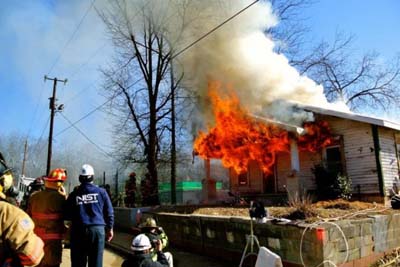
Almost 500 fire service personnel from 15 states are registered as observers throughout the eight days of burn. (ISFSI photo)
Although there have been multiple house fires in the same Spartanburg, S.C. neighborhood in the past week, firefighters aren’t concerned.
That’s because they’re the ones setting the fires. And, they’re doing it for a good reason – research.
In addition to typical furniture found in any single-family homes such as a couch, chairs, end tables, lamps, beds and coffee tables, these have been equipped with sensors, monitors and special equipment for video-taping.
Researchers from the National Institute of Standards and Technology (NIST) are spear-heading the project studying the effects of firefighting techniques.
“The purpose is to translate science and research into training,” explained S.C. Fire Marshal Shane Ray. “This may very well change the way we do business…”
Firefighters, both career and volunteer, from a number of departments are participating in the study, funded by a $618,696 AFG grant to the International Society of Fire Service Instructors (ISFSI).
Ray explained to study the impact of various fire attacks, crews are given different scenarios. Some involve only exterior attacks, some interior, some both. Monitoring equipment also is being used to determine whether closed doors make a difference.
“We’re also seeing what happens when furniture burns and is doused with water. We want to know what gases there are,” Ray said, adding that the whole purpose of the study is to improve firefighter safety and effectiveness.
NIST researchers explained that the experiments demonstrate “firefighting methods—individually and in combinations—for strategically ventilating and isolating fires to prevent—or at least delay—flashover, the extremely perilous phenomenon that occurs when heat builds up in a burning structure’s contents and components to the point that they burst into flames simultaneously.”
The recorded drills and scenarios continue this week through Wednesday.
When the project kicked off last week, more than 160 fire service officials and others were on hand. And, there was much more to experience than simply watching houses burn.
They were able to watch the interior firefighting effort as well as sensors that were monitoring temperatures while Dan Madrzykowski, NIST fire protection engineer, narrated.
“It was just incredible. Dan did a great job explaining what was happening, and he did it so a layperson like me understood,” said Cathy Hedrick, an official with the NFFF.
“While we were watching the live videos, you could hear a pin drop in the tent. Everyone was watching intently. It was incredible to see what was happening.”
Hedrick, who told the crowd about losing her firefighter son, Kenny, in a Maryland house fire 21 years ago, said she was impressed with the research, and hopes it sparks a change in firefighter tactics.
“Nothing has changed. We’re still killing firefighters the same way we did when Kenny was killed,” she said in a telephone interview Monday morning.
Hedrick, who works with fallen firefighters’ survivors, said crews need to know they can’t keep doing the same things they’ve been doing for years. Fires are different now, but unfortunately, tactics have not caught up.
“There are new theories in tactics, and we have to get firefighters to understand and accept that. It’s the only way were going to save both firefighters and civilians lives.”
Hedrick said Madrzykowski explained while they watched the scenarios how firefighters can still be aggressive, but safe.
“Getting water on the fire first to reduce the interior temperature was one of the changes I saw. Getting firefighters to do that instead of busting in through the front door would be one change in culture that needs to take place. He showed the research behind the tactic…”
The woman who travels across the country speaking about firefighter safety said she hopes fire officials not only read and see the research but translate it into the way they do the business.
“I hope they look at the findings with an open mind. They have to realize it’s time to change. It’s time to get away from ‘that’s the way it’s always been done’ attitude.”
SUSAN NICOL / Source: EMSWORLD.COM NEWS
| ![]()




